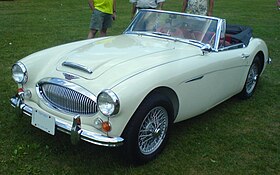| Austin-Healey 3000 | |
|---|---|
 Austin Healey 3000 sports convertible | |
| Overview | |
| Manufacturer | Austin-Healey (BMC) |
| Production | 1959–1967 |
| Assembly | Abingdon, England |
| Body and chassis | |
| Class | Sports car |
| Body style | 2-door 2 or 2+2 seater roadster then convertible |
| Layout | FR layout |
| Powertrain | |
| Engine | 2,912 cc (2.9 L) C-Series I6 |
| Dimensions | |
| Wheelbase | |
| Length | 157 in (3,988 mm)[1] |
| Width | 60 in (1,524 mm)[1] |
| Height | 46 in (1,168 mm) (Hood down) 49.5 in (1,257 mm) (hard top)[1] |
| Kerb weight | 2,550 lb (1,157 kg) |
| Chronology | |
| Predecessor | Austin-Healey 100-6 |
| Successor | MG MGC |
The Austin-Healey 3000 is a British sports car built from 1959 until 1967. It is the best known of the "big Healey" models. The car's bodywork was made by Jensen Motors and the vehicles were assembled at BMC's MG Works in Abingdon, alongside the corporation's MG models.
During its production life, the car changed from an open sports car, albeit with a child-transporting 2+2 option, to a sports convertible. In 1963, 91.5 percent of all Austin-Healey 3000 cars were exported; mostly to North America. The 3-litre 3000 was a highly successful car, which won its class in many European rallies in its heyday and is still raced in classic car competitions by enthusiasts today.
British Motor Corporation ended manufacture in 1967, filling its place with a car with a new, though similar, engine in a newer monocoque chassis; the MGB variant named the MGC.